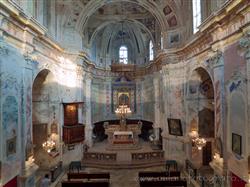|
Mottalciata (Biella)- Church of San Vincenzo
|
|
|
Show to visit in the Biella area: |
 The church of San Vincenzo in Mottalciata has Romanesque origins, but the current version was built between 1740 and 1781. The church of San Vincenzo in Mottalciata has Romanesque origins, but the current version was built between 1740 and 1781.
The church is located outside the town and this has always made it difficult to use it as a parish church.
The structure of the church is in exposed brick with the addition of river pebbles and with only the facade plastered. The latter is dominated by a large pronaos which extends over its entire width and reaches about three-fifths of its height. The façade is then vertically marked by four pilasters with Corinthian capitals and at the apex there is a large pediment with a small ellipsoidal window in the center. There is also a larger round window in the upper half, visible only from a distance because up close it is hidden by the pronaos.
The only decorations on the facade are some plant-themed stuccos and the sober entrance portal.
The bell tower of the church is in its lower part still that of the original Romanesque church, with the typical decoration with hanging arches. At the base, in particular, there is a herringbone masonry of considerable thickness (up to 1.50 m).
The upper part of the bell tower dates back to 1725. Note that the belfry opens outwards through serlianas.
The interior of the church has a single nave with a barrel vault and two side chapels on each side. All the internal surfaces are covered with multicolored decorations, neoclassical in style but chromatically still baroque. Very present are the surfaces decorated in order to simulate marble. The internal decorations of the church were made in 1781 and would require a further decisive restoration because they appear very damaged in many parts.
It should be noted that the windows of the church, placed high up in the lunettes of the vault, are walled up on the left side, although structurally present also on that side. Inside, the windows on the left are simulated by the decoration, to re-establish the symmetry with the right side.
In the semicircular apse (Fig. 2) the decorations simulate pilasters and panels that do not actually exist. It houses a precious altar decorated with polychrome marble on a brick masonry structure and is separated from the nave by a red marble balustrade, sculpted by Apollonio Colombara (1779-1780).
In the center of the back wall a painting on wood of the 2nd half of
sec. sixteenth century depicting the Virgin and Child, St. Vincent and St. John the Baptist of the Vercelli school (Fig. 4).
The lower part of the wall is occupied by a wooden choir.
On the counter-façade, above the compass, there is a choir with a curvilinear wooden balustrade with typical plant and musical instruments decorations. The choir houses an organ (Fig. 5).
Other elements of interest of the church are represented by:
- The confessional in solid walnut, work of the master Carlo Trabucco di Mosso and dated 1679
- The walnut pulpit sculpted by G.A. Mazza and Tommaso Marchisio with
sculptures attributable to the Serpentiere (1785) (Fig. 3)
- The baptistery (an.1777), also the work of the Serpentiere
- Frescoes from the Novara school of the ancient parish church incorporated into the external walls of the current church (dated 1518)
The town cemetery, until 1935, when the current one was built, was always on the square, on the right side of the church, where many burials still exist today.
On the counter-façade, above the entrance, there is a choir with a curved wooden balustrade with the typical plant and musical decorations. The choir houses an organ (Fig. 5).
Other elements of interest of the church are represented by:
- The solid walnut confessional is the work of master Carlo Trabucco di Mosso and dated 1679
- The walnut pulpit sculpted by G.A. Mazza and Tommaso Marchisio with
sculptures attributable to the Serpentiere (1785)(Fig. 3)
- The wooden cover of the baptismal font (an.1777), also the work of the Serpentiere
- Frescoes of the Novara school of the ancient parish church incorporated into the external walls of the current church (an.1518)
The town cemetery, until 1935, when the current one was built, was always on the square, on the right side of the church, where many burials still exist today.
Categories: Places of historical value of artistic value
45.51867, 8.20959 |
Church of San Vincenzo: Further pictures in the section Photography |